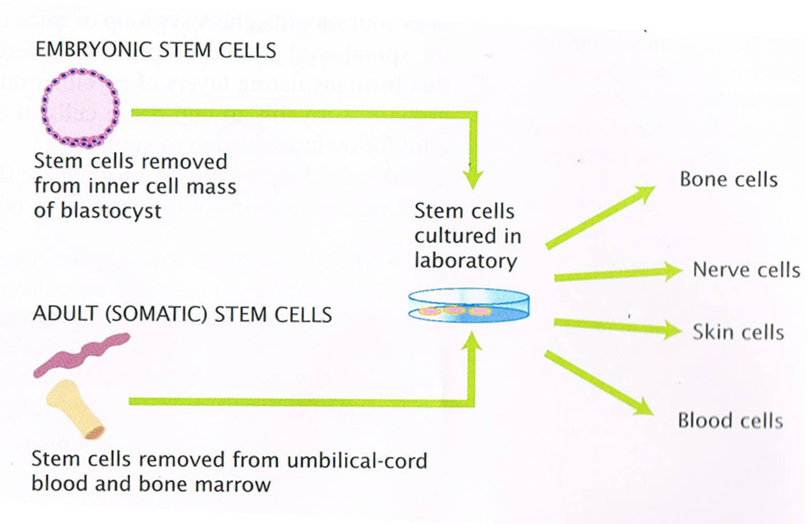Stem Cells Blog by: Ana Djuirca
1.What are stem cells?
“Cartman:
Doctor, can you tell me exactly how stem cells work?
Doctor: Well you have trillions of cells in your body, heart cells, skin cells, brain cells and so on. But before a cell is designated as a toenail cell, or a pancreas cell, it's what we call a stem cell. Sort of like a blank cell, do you understand?
Cartman: Not at all, but go on.” (
Doctor: Well you have trillions of cells in your body, heart cells, skin cells, brain cells and so on. But before a cell is designated as a toenail cell, or a pancreas cell, it's what we call a stem cell. Sort of like a blank cell, do you understand?
Cartman: Not at all, but go on.” (
Giving
it a more scientific definition, according to "Stem Cell Basics." : Introduction [Stem Cell Information]. N.p., n.d. Web. 04 Oct. 2015. "Stem cells have the remarkable potential to develop into many
different cell types in the body during early life and growth. In addition, in
many tissues they serve as a sort of internal repair system, dividing
essentially without limit to replenish other cells as long as the person or
animal is still alive. When a stem cell divides, each new cell has the
potential either to remain a stem cell or become another type of cell with a
more specialized function, such as a muscle cell, a red blood cell, or a brain
cell. Until recently, scientists primarily worked with two kinds of stem cells
from animals and humans: embryonic stem cells and non-embryonic(adult)."
2. What are similarities and
differences between embryonic and adult stem cells?

Regarding the therapeutic purposes,
both types have their advantages and disadvantages. One big difference between
embryonic and adult stem cells is in their different abilities in the number
and type of differentiated cell types they can become. Embryonic stem cells can
become any kind of cell type in our body because they are pluripotent1,
adult stem cells are limited to differentiating into different cell types of
their tissue of origin. The use of adult(non-embryonic)stem cells and tissues
derived from the patient's own adult stem cells would mean that the cells are
less likely to be rejected by the immune system. This is a major advantage.
3. What are the purposes of stem cells?
According to "Stem Cell Basics." : Introduction [Stem Cell Information]. N.p., n.d. Web. 04 Oct. 2015. ,“Perhaps the most important potential
application of human stem cells is the generation of cells and tissues that
could be used for cell-based therapies.
Today, donated organs and tissues are often used to replace ailing or destroyed
tissue, but the need for transplantable tissues and organs far outweighs the
available supply. Stem cells, directed to differentiate into specific cell types,
offer the possibility of a renewable source of replacement cells and tissues to
treat diseases including macular degeneration, spinal cord injury, stroke,
burns, heart disease, diabetes, osteoarthritis, and rheumatoid arthritis.”
4. Something interesting to add about stem cells?
Yes, a lot of it actually.
- Third source of stem cells. According to"Online Biology Degree." Online Biology Degree RSS. N.p., n.d. Web. 04 Oct. 2015. "Embryo or adult aren’t the only two places one can get stem cells. Blood used from the umbilical cord made during pregnancies is also a good source. And the results can be impressive. In 2006, researchers at the University of Minnesota announced they were able to largely reverse the effects of strokes in lab rats using stem cells found in human umbilical cord blood."
- States still CAN decide. Although the federal government might have agreed on research of stem cells, each and every one of the 50 states in the US is free to pass their own laws. Ex: in 2010 Minnesota changed it's ban on paying scientists to engage in all forms of human cloning. The University of Minnesota was a major supporter of the funding and announced that by destroying the organism 5-10 days after making it, that it's not cloning.
- Stem cells in space. It is widely know that astronauts with their return to Earth, have problems with regeneration of their mucle tissue. They are really weak and they need a lot of time to recover from the journey. NASA think that it might just be stem cells, that can help them in the process of recovery from the "trip".
5. Stem cell joke?
Yep.
And the above interesting facts
you may not know about stem cell research are just the beginning to debates and
future decisions on the topic. With so much more to be learned from the
benefits versus the cost of stem cell research, there is still more to be said
and discovered.

WWW: your quotations and citations are included, pictures and general presentation is good
ReplyDeleteEBI: you included captions to the pictures, as well as defined stem cells in your own words
-Ajda&Celine
WWW: I like your definition from the show
ReplyDeleteEBI: You coud add citations to your pictures and refer to them in the text.
Macular degeneration is a chronic eye disease. This disease is the leading cause of vision. This disease can control by the treatment. Macular degeneration treatment
ReplyDelete